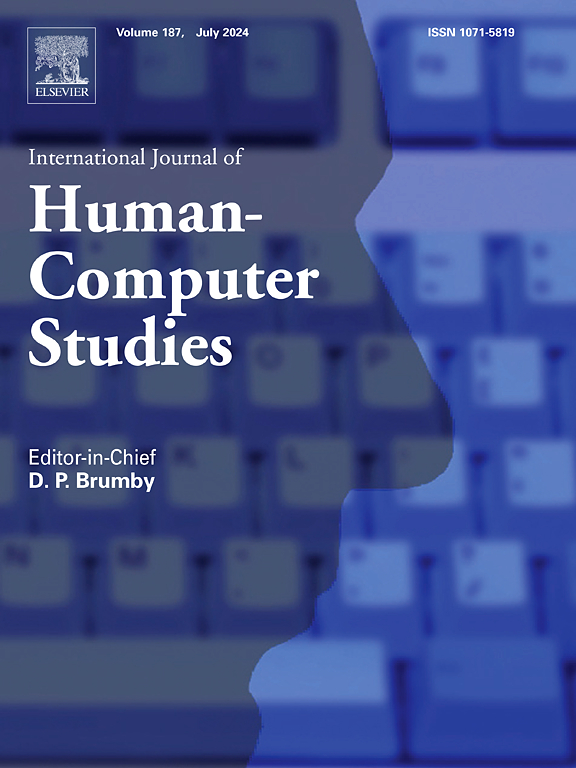Limits of speech in connected homes: Experimental comparison of self-reporting tools for human activity recognition
IF 5.3
2区 计算机科学
Q1 COMPUTER SCIENCE, CYBERNETICS
International Journal of Human-Computer Studies
Pub Date : 2024-11-20
DOI:10.1016/j.ijhcs.2024.103404
引用次数: 0
Abstract
Data annotation for human activity recognition is a well-known challenge for researchers. In particular, annotation in daily life settings relies on self-reporting tools with unknown accuracy. Speech is a promising interface for activity labeling. In this work, we compare the accuracy of two commercially available tools for annotation: voice diaries and connected buttons. We retrofit the water meters of thirty homes in the USA for infrastructure-mediated sensing. Participants are split into equal groups and receive one of the self-reporting tools. The balanced accuracy metric is transferred from the field of machine learning to the evaluation of the annotation performance. Our results show that connected buttons perform significantly better than the voice diary, with 92% median accuracy and 65% median reporting rate. Using questionnaire answers, we highlight that annotation performance is impacted by habit formation and sentiments toward the annotation tool. The use case for data annotation is to disaggregate water meter data into human activities beyond the point of use. We show that it is feasible with a machine-learning model and the corrected annotations. Finally, we formulate recommendations for the design of studies and intelligent environments around the key ideas of proportionality and immediacy.
联网家庭中语音的局限性:人类活动识别自我报告工具的实验比较
人类活动识别的数据标注是研究人员面临的一个众所周知的挑战。特别是,日常生活中的标注依赖于自我报告工具,其准确性尚不可知。语音是一种很有前景的活动标注界面。在这项工作中,我们比较了两种市售注释工具的准确性:语音日记和连接按钮。我们对美国 30 户家庭的水表进行了改造,以实现以基础设施为媒介的传感。参与者被分成人数相等的两组,并接受其中一种自我报告工具。平衡准确度指标从机器学习领域转移到注释性能评估领域。我们的结果表明,连接按钮的性能明显优于语音日记,准确率中位数为 92%,报告率中位数为 65%。通过问卷回答,我们强调了注释性能受习惯养成和对注释工具的情感影响。数据标注的用例是将水表数据分解为使用点以外的人类活动。我们证明,利用机器学习模型和修正后的注释是可行的。最后,我们围绕 "比例性 "和 "即时性 "的关键理念,为研究和智能环境的设计提出了建议。
本文章由计算机程序翻译,如有差异,请以英文原文为准。
求助全文
约1分钟内获得全文
求助全文
来源期刊

International Journal of Human-Computer Studies
工程技术-计算机:控制论
CiteScore
11.50
自引率
5.60%
发文量
108
审稿时长
3 months
期刊介绍:
The International Journal of Human-Computer Studies publishes original research over the whole spectrum of work relevant to the theory and practice of innovative interactive systems. The journal is inherently interdisciplinary, covering research in computing, artificial intelligence, psychology, linguistics, communication, design, engineering, and social organization, which is relevant to the design, analysis, evaluation and application of innovative interactive systems. Papers at the boundaries of these disciplines are especially welcome, as it is our view that interdisciplinary approaches are needed for producing theoretical insights in this complex area and for effective deployment of innovative technologies in concrete user communities.
Research areas relevant to the journal include, but are not limited to:
• Innovative interaction techniques
• Multimodal interaction
• Speech interaction
• Graphic interaction
• Natural language interaction
• Interaction in mobile and embedded systems
• Interface design and evaluation methodologies
• Design and evaluation of innovative interactive systems
• User interface prototyping and management systems
• Ubiquitous computing
• Wearable computers
• Pervasive computing
• Affective computing
• Empirical studies of user behaviour
• Empirical studies of programming and software engineering
• Computer supported cooperative work
• Computer mediated communication
• Virtual reality
• Mixed and augmented Reality
• Intelligent user interfaces
• Presence
...
 求助内容:
求助内容: 应助结果提醒方式:
应助结果提醒方式:


